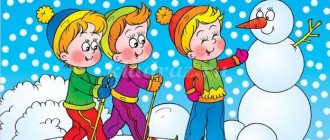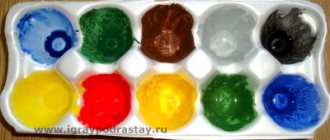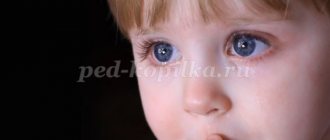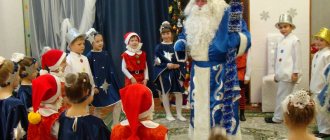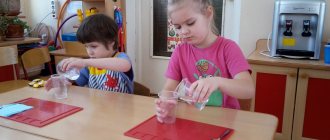Olga Andreeva
Card file of winter walks in the preparatory group
Observation #1
Observing changes in nature. Offer to look for signs of winter on your own.
Riddle: Powdered the paths,
I decorated the windows.
Gave joy to children
And I went for a sledding ride. (Winter)
Didactic game “Who is bigger?”
- practice selecting definitions for nouns.
What words can you use to describe winter? What's winter like? (magical, fairy-tale, snowy, frosty, blizzard, sparkling, magical winter, cold, beautiful, etc.)
Monitoring seasonal changes
Goals:
• form ideas about changes in nature at the beginning of winter (the night becomes longer and the day decreases)
;
• learn to distinguish the characteristic signs of the beginning of winter, recognize them in poems.
Experimenting and experiences while walking in winter
Preschool age is characterized by a special interest in the world around us. Often, a child cannot notice some fundamental things on his own, so it is important for a teacher to teach him not only to look, but also to see. Theoretical knowledge should be supported by visual material and experiments that can enrich children’s knowledge.
Experimentation on walks is divided into two types:
- Frontal - when children have several objects to observe and compare independently. For this type of observation, it is recommended to have two teachers monitoring the students, especially if the group is large.
- Demonstration - the teacher holds in his hands the object that has been selected for teaching. The teacher demonstrates the object and conducts an educational conversation. This method dampens initiative and activity; as a rule, preschoolers are not very interested in activities in which they must only observe without participating.
Finger painting for children in kindergarten
Important! Experiments that will be conducted with children must be selected in accordance with their development and age.
Experiments for preschoolers are not entertainment, but a way of teaching children, their acquaintance with the environment and life. Such walks can be done in the format of an open lesson, with the invitation of parents.
MAGAZINE Preschooler.RF
Author of the development: Lyudmila Gennadievna Maramygina, teacher of the preparatory group of the preschool educational institution “Kindergarten “Smile” in Nadym.” Time: walk, designed in accordance with the thematic week: “Frosty Winter” at the preschool educational institution. Direction: Cognitive - speech development. Program content: Purpose: To determine the characteristics of winter in the far north.Training tasks: O.O. “Communication”: consolidate children’s knowledge about the peculiarities of the natural conditions of the Far North O.O. “Cognition”: Provide children with opportunities for research, search activities, and experimentation while walking. Expand children's knowledge on the topic “Frosty winter”. Continue to formulate rules of behavior in society. O.O. “Safety”: reinforce the rules of safe behavior while walking and going downhill. Ensure multifunctional use of the walking area in winter. Developmental tasks: O.O. “Socialization”: develop independent play behavior and interactions of children in a play subgroup. O.O. “Communication”: develop children’s speech activity through complete answers to questions. O.O. “Physical education”: to develop children’s motor activity, accuracy, eye, strength, dexterity. Promote the harmonious physical development of children. O.O. “Health” improves the health of children during walks. Educational objectives: O.O. “Labor”: to cultivate a value-based attitude towards work and its results; teach children to clean up their toys and work tools. Integration of educational areas: “Communication”, “Labor”, “Socialization”, “Safety”, “Physical education”. Equipment: shovels, take-out material, sand buckets, skis, bright cubes, snowballs or plastic balls. For experience (mitten). Preliminary work 9.12. On Monday they bring a letter. Contents of the letter: “Dear guys, employees of the Moscow Research Institute are writing to you. We are studying the Arctic and the characteristics of the winter season. On December 2, an international conference on this issue began in Moscow. Research by scientists on studying the characteristics of winter in desert conditions, in steppe conditions, and in central Russia was presented. But, unfortunately, no one has presented a study of the characteristics of winter in the Far North. We invite you to take part in our conference.” Educator: What should we do? How can we take part in the conference? Expected answers from the children: You can draw pictures about the northern winter and send them by letter, you can go yourself and tell them what winter is like here, tell them on Skype. Educator: Okay, if we draw our winter and send the drawings by mail, we will be late, because... The letter is taking a very long time, the conference is already over! You can go there yourself. Who will go? I think everyone wants to go, but it’s very expensive by plane, we don’t have that kind of money, and we have to buy train tickets in advance. Educator: But tell me, if we don’t know something, where and how can we get answers to the questions that interest us? Expected answers from children: Ask parents, watch a program on TV, find interesting things in books, etc. Educator: What to do? You and I looked at so many interesting things in presentations about the desert, about the Tundra. How can we do this ourselves? Encourage children to try making a scientific report themselves. Watch scientific videos, how are they made? Let the children know that there is television in the city, where real reporters work, and you can invite them to make our scientific research film. But first we need to look at what exactly science films are talking about. Over the course of two days, children are prepared for scientific research on “the characteristics of winter in the Far North.” During preparation, children watch research films on various topics, pay attention to the features of such films (plot, structure, content), and determine the range of issues that children will cover in the research film. A teacher with children makes an application to the head of the preschool educational institution G.V. Podgornaya. about inviting television to film a research video for an international conference.
• reviewing children's preschool encyclopedias about the world around them on the topics: “climatic zones”, “science”, “animals of the North • watching a cartoon about the bear cub Umka; animated film "Little Penguin Lolo"; • artistic and aesthetic activities - drawing on the topics: “Northern Lights”, “Northern Landscape”; • S/r game “Reporter”; S/r game “Journalist” • game situation “Getting ready for a trip” (which is necessary for a traveler); • playing outdoor and sports games that can only be played in winter; • use of facial studies, elements of psycho-gymnastics.
On the day when the video report will be carried out before the walk, prepare the children for the fact that each child will have a small microphone attached to their clothes, which will transmit all sounds to the video camera, so you need to speak loudly, do not interrupt others, but lean towards it no need.
Children go outside, and while moving to the site, a conversation takes place about winter, through the use of interviewing techniques.
Educator: Guys, we are starting to shoot a scientific film, are you ready to tell the staff of the Moscow Research Institute about this? Check if everyone's microphones are working? Is the camera ready? -Tell me, what time of year is it in the North now? (Winter). - Tell me what signs of winter you know. (Children's answers) -Name the winter months (December, January, February) -And in the North, when does winter begin? (Much earlier, this year it started back in November) - And what is winter like in our Far North, tell us. (Very cold, frosty, very windy, lingering, beautiful) - Guys, let’s remember what days and nights are like in winter, what the sky in winter and what sunshine. -What happens in windy weather? (snow drift, blizzard, blizzard) What happens to reservoirs in winter. What interesting things does the frost leave early in the morning? -Guys, let's remember how plants overwinter in winter! (Trees and bushes stand without leaves. In winter they do not feed, do not grow, as they fall into deep sleep.) -Why is this happening? (In winter there is little moisture, light, and nutrients that plants need. Grass seeds and flower bulbs overwinter under the snow). - Guys, why are there so few birds on the street (With the cold weather, insects disappeared, there was little other food for birds (seeds, berries), so some of the birds flew away, and those that remained moved closer to human habitation (it’s easier to find food here and it’s warmer ).People feed birds, help them survive in the cold season. -Guys, tell me, how do animals live in the forest? (Everything is different. The bunny and the squirrel changed their coats for winter ones. The squirrel eats its autumn reserves. The fox does this time moves. The bear and badger, having accumulated a thick layer of fat in the warmth over the summer and autumn, sleep in dens and burrows. The hedgehog also sleeps. Obstacles arise on the way for the children and the teacher (“a river covered with ice”) Teacher: Oh, guys, look in front of us is a river covered with ice, residents of southern countries do not know how to overcome this obstacle in winter, but you know what you can use to walk on thin ice (put on skates) Let's put on skates and ride them on the ice, just be careful. Imitation of movements Oh, guys, be careful here, there are further snowdrifts! How can we get through here? (jump over)
They jump over. And there is deep snow here, can we walk in felt boots? There are some two stripes here (if the children don’t say, prompt, ski track) we probably need to change our shoes or (we need to put on skis) Imitation of movements We need to hurry. And who would help us get quickly across the tundra, across a snow-covered field? (reindeer) (organize reindeer sleds) Educator: Well, finally, we got to our site. Educator: Guys, residents of southern countries who came to the conference probably don’t know how people’s work changes in winter? (In winter, people clear snow. Snow removal machines are working.) Educator: I once saw that in winter all the roads are sprinkled with something. And I still can’t understand what they sprinkle it with, why they do it? (Children's answers). The teacher’s task is to lead children to the fact that this is for safety reasons. Conclude: Yes, correctly, the snow cover becomes slippery and when moving fast the road is dangerous, but if you sprinkle it with sand, then movement becomes safe. Look at our site, is everything here in a safe condition? (Children's answers). No. How to fix this situation? Children suggest sprinkling sand on dangerous areas. Labor activity, children sprinkle the playground on the slide and the steps with sand, colored hummocks, steps near the ship, around the “icy Christmas tree” and the “Brownie” amulet, a log. Educator: I suggest that our strong boys take buckets of sand, and the girls take shovels, because they will be able to carefully scatter the sand and divide into pairs. Who chooses to sprinkle the steps on the ship around the snowy buildings, and who wants to sprinkle colored hummocks, and who wants to sprinkle a log on top, there remains an icy Christmas tree and the platform and steps on the hill - everything has been distributed, and now you can choose tools and try to secure our site. Educator: Guys, let's remember other safety rules in the area during games: • Don't push when we run; • we don’t fight with our blades when working, we don’t climb onto the ship; • we do not touch iron objects with our hands; • we take turns riding the slide, waiting for the child who rode to leave; • we play only in our area. Well, now we remember how safe it is to play in our area in winter. Educator: Guys, we talked about the signs of winter, about work in winter, and what else can you do outside in winter? (Play) Let's tell you how and what you can play for our film. Children's answers. Maybe we can show how to play Rus.nar and “Snow Woman” to the conference participants?
With the help of a counting rhyme, the driver is selected - “Snow Woman”. She is squatting at the end of the platform. The children walk towards her, stamping their feet.
“The snow woman sits, At night she dozes, she sleeps during the day, In the evenings she waits quietly, At night she goes to scare everyone.” To these words, the “snow woman” wakes up and catches up with the children. Whoever he catches becomes a “snow woman”
The game is played 2-3 times. Educator: And you and I also know the snow game.
Winter fun "Snow Carousel"
Holding hands, children form a circle around a snow building (house) and turn into snowflakes. At the teacher’s signal, they walk slowly at first, then faster and faster, and finally run. After the players have run several laps, the leader says: “The wind has changed, the snowflakes have flown in the other direction.” Children slow down, stop and begin to move in the opposite direction, gradually increasing the pace until the teacher says: “The wind has completely died down and the snowflakes calmly fall to the ground.” The movement of the snow carousel slows down, the children stop and let go of their hands. Educator: Guys, run quickly, look at each other here, what your cheeks and nose have become. Why did this happen? (Children's answers) Rub the back of the mitten on your frozen cheek or nose. Experimental activity “How to warm your hands and cheeks?” How did you feel? (the cheek is first warm, then hot).
Children conclude that objects can heat up through friction and movement. Educator: I think that now residents of southern countries will know what to do if their cheeks or nose suddenly freeze. Educator: Guys, I suggest you play one more game, which can only be played in winter. Winter fun "Who's Next" Children tell the rules of the game for the conference participants.
The players stand in a line, holding a snowball in each hand. At the teacher’s command “Throw with your right (left)!” everyone simultaneously tries to throw the snowball as far as possible towards a fence or other landmark. Whose snowball flies the farthest is considered the winner. Educator: Now you can play the games yourself, and our operator will film everything on a video camera. Individual game. Children with high physical activity Winter fun “Snipers” - develop accuracy and eye. Individual game Children with low motor activity: “Who is faster on skis” Purpose: practicing a sliding step. Individual game: Independent activity. Skiing, sledding, snowball fights. Educator: Guys, we made our scientific video. Why did we do this? Remind please. (For conference participants) What was this film about? (About the peculiarities of winter in the Far North.) Now we will be able to send it by e-mail and in a few minutes our film will be seen in Moscow. The outcome is carried out in a group by watching a video. Invite the children to watch the video together and analyze it. (What worked, and what still needs to be improved and re-shot). Letter “Dear guys, employees of the Moscow Research Institute are writing to you. We are studying the Arctic and the characteristics of the winter season. On December 2, an international conference on this issue began in Moscow. Research by scientists on studying the characteristics of winter in desert conditions, in steppe conditions, and in central Russia was presented. But, unfortunately, no one has presented a study of the characteristics of winter in the Far North. We invite you to take part in our conference.”
| Next > |
